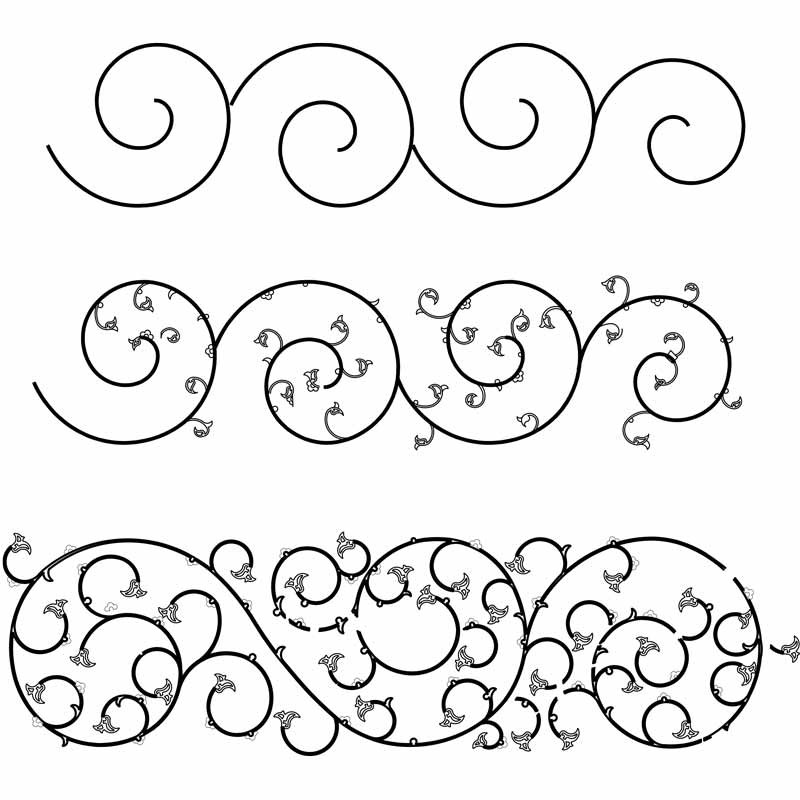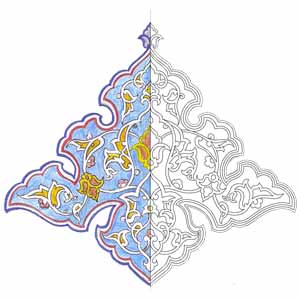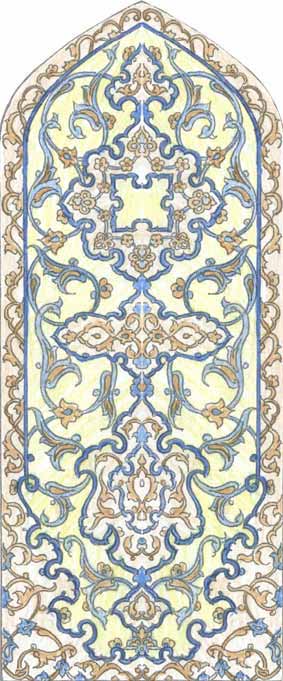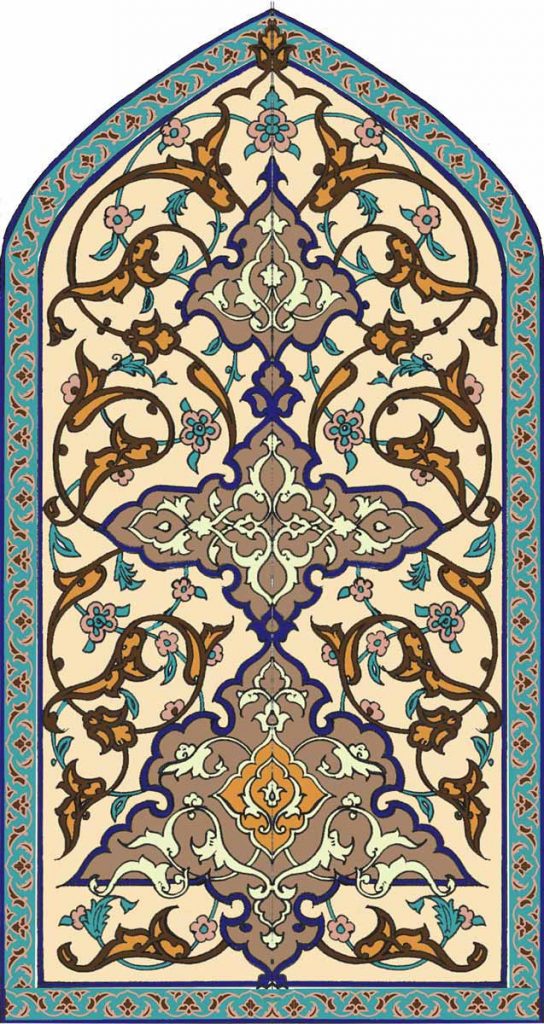

“Arabesque” is a western word and “IslimiI” is an Arabic word respectively meaning “related to Arab” and “related to Islam”. Therefore the Arabesque and Islimi design suggest a design that is related to Arabs and Muslims or is it their invention and is used by them.
This ornamental design, often foliated and floral, is used in almost all Islamic era and can be considered as a factor of artistic coexistence and unity in Islamic art. It also can be placed in the same position as the Arabic calligraphy. This decoration addresses all issues of religion such as faith, light and illumination, the presence of nature, modesty, diversity in motifs and unity in content. It symbolises a common sense and is a united language in all Islamic artworks at different times. The origins of Islamic decorative motifs are in the leafy forms (vine leaves), palmettes (palm leaves), lotus flowers and elephant’s trunk.
In this article, we are going to write about:
- What are the essential elements in the arabesque motifs?
- What is the role of Arabesque or Islimi motifs in architecture?
- Which kinds of arabesque designs are used in decoration?
- Identify and study arabesque motifs in Islamic and other architectural decoration

What is Arabesque?
Arabesque is a style of decoration with precise geometric shapes and simplified foliated patterns (stylised and conventional) and away from nature (abstract) with recurring harmonious tendrils and mazes. It also can be named Islamic interlace, scroll designs, scroll decoration designs, or foliate ornament. Historically, Arabesque originated from the vine leaves, where there are complexities and truncations of leaves, stems and branches. So far, Arabesque motifs have been inspired by leaves of the vine, palmettes (palm leaves), figs, acanthus and other plant organs. Arabesque motifs are used in various architectural decorations including Muqarnas, plastering, Stucco, tiles as well as sculpture, metalwork, gilding, carving, carpet, pottery, pottery, books illustrations, miniature painting and calligraphy.
Arabesque is a feminine name in fine arts, ornamentation, or sculpture applied to the decorations. The ideal line and the interface of some edges are the basis of a painted or carved composition. (Encyclopedia of Fine Arts). In ancient French texts, the word borrowed from Italian “Arbesco” which is an Arabic equivalent. This ornamental element, painted or sculpted in low relief motifs, usually extends itself on a single surface and falls on a bare background. This ornament often enables continuous lines, connecting elements that adorn the field without forming unbalanced masses (Grand. 1960).
Elements of arabesque
Arabesque as a unique foliate design with the form of ivy, clover, palm or rose extends in an endless repeat. The columns’ capitals are also decorated with arabesques. The calligraphy and scrolls are created on the backdrop of arabesques. The best place to start exploring the evolution of makeup in the first phase of Islamic art is the exterior of the Qasr Al-Mshatta (Jordan winter palace which its facade, has been removed and is on display at the Pergamon Museum in Berlin). On the left wall of the gate, animal motifs are carved between the vine leaves or circular stems, while on the right wall of the gate, only the foliate forms are used. The diligent effort done here to make the leaf and stem shape of the vine beautifully embellish can well represent the style and the creation of “Arabesque” (Zaki Muhammad Hassan).
Arabesque designs basically represent a schema of a precise tree with all its twisted branches, leaves and foliage that have been abstracted. Sometimes it is a visual representation of an excited and curved snake body and sometimes a combination of lines reminiscent of the elephant’s trunk. The harmonious circulation of arabesque designs with continuous curves encompasses all the details of the plants, such as the leaves, flowers and buds. It establishes a kind of harmony and order among the components of the artwork. Pomegranates, figs, palm, acanthus and vine leaves are more commonly used in arabesque than other trees.
The concept of arabesque
The arabesque concept can be confined to those formations in which the art of the Near East was born and, more precisely, to those forms of Islimi whose main system of formation is the two-branch forms with The curvy and soft nature. It is regarded as the most common element of Islamic art expression.
These forms represent publications and imitations, which crystalize the reflection of the Arab soul. It owes its roots and inspirations to the physical materials and real elements that range from palm leaf shapes (palmette) to the organs of plants: Branches and leaves, sometimes lily-like flowers, sometimes resembling calyxes and petals, and occasionally climbing plants. It has traces in similar artworks in the world, but only in Muslim lands finds its particular formations and independent visual purposes and expressions.
Khatai motifs
“Khata” also means flowering plants, as well as an area of China, called “Khata.”
The Khatai motifs are the stems which are like a string on which the flowers, buds, leaves, and branches lie. Khatai motifs consist of balanced mazes. Some believe that such designs were brought from China during the Mongol era and are therefore called Khatai. However, the evolution of floral designs in different periods from the Achaemenian period to the present shows these motifs are used in this period and has evolved gradually. Therefore similarity of these themes has been due to the political, cultural and commercial relations between the two civilisations in Asia. In other words, Khatai is a delicate style of arabesque with flowers, shrubs and buds.
Khati designs rotate according to space and geometric patterns on the surface of the artwork, like arabesques. The artist has to use these motifs to fill parts of a carpet or tile. These designs are, in fact, the means of creating order and unity among the components of an artwork.
The principle of drawing a Khatai motif is based on circular designs. By the combination of the circles, various types of Khatai flowers are created in the form of buds, blooms and complete flower with has abstract effects. The most full-blown flower in the Khatai collection is known as four o’clock flower.
Some motifs used in Khatai are four-o’clock flower, pomegranate blossom, Ivy, Bud, lotus flower, Pentas, pinwheel flower, calyx, grapevine leaves, grape cluster, paisley, Palm, fig, etc. The Khatai components include leaves, flowers, buds, and straps.
There are some essential points in Khatai designs. Firstly the parts of the stem design are thicker, and some other parts are thinner, like stems in nature. Secondly, the main flower of the Khatai design must be where that captures the viewer’s attention. Furthermore, Leaves, flowers, and buds should also be commensurate with the central flower.
History of arabesque decorations
The first motifs inside the caves, on rocks and pottery, were painted by early humans. But gradually, over time, human beings were able to evolve them. The motifs cover a variety of subjects including humans, plants, animals and other objects. A group of motifs that are inspired by plants in nature are called foliate motifs. Some foliate motifs are used as decorative elements in many art industries, including architecture or crafts. These motifs are sometimes found solitary and sometimes in combination with other motifs, including simple geometric patterns. Muslim artists contributed significantly to the design and implementation of these motifs and achieved remarkable feats in this art.
This decorating themes are known as Arabic and Islamic designs and seem to be one of the innovations of the Islamic era. But it was occasionally used before the advent of Islam, and some writers have referred to each of them and related it to one particular region.
Georges Marçais, author of the Islamic Art (book), cites some of its origins in Hellenistic (Greek) ornamentation:
“But, on the other hand, it is noted that the main role played by the Fatimid flower, especially in the Al-Hakim Mosque the flower which connects it to stem with a narrow strand, is the essential element of the Hellenic ornamental fringe from which the arabesque.”
Georges Marçais
Grand Larousse encyclopédique attributed arabesque to the Roman Empire and revived during the Italian Renaissance:
“Mumbai painters and carvers have confined the margins of the rooms and door frames to the arabesque. These ornaments must have become common simultaneous with the Italian Renaissance.”
Using foliate motifs in art and architecture has evolved since the fifteenth century. But it has been declining again since the 19th century. In the traditional design, according to the way of drawing the lines of the motifs are divided into two categories: The first category are motifs that are drawn with straight lines and angular shapes, which are called broken motifs. The second category is motifs with curved lines that are called circular mazes. Arabesque and Khatai foliate motifs are of the second type, rotating motifs. Examples of such designs can be found in pre-Islamic plaster casts.
Since the 19th century, Muslim artists imitated naturalistic designs of Western artists. Therefore decorating by Arabesque and Khatai motifs decreased.
Arabesque in ancient art and architecture
Some of the old samples of arabesque are mentioned below:
Egypt:
A ring belonging to the 12th Dynasty (2000-2212 BC) which exists in the Cairo Museum. It has four quadri-petal flower-like designs with nine delicate stems in both sides. The stems have five-petal flowers and leaves and small buds.
Alhakim Mosque, Cairo, which was built in the 10th century, has a beautiful Islamic slate in its decorative stuccos. It is a stylized stem that gives branches symmetrically on its sides. These branches rotate to their left and right, some leading to leaves, and some induce tendrils.
Mesopotamia:
A scene from Ashurbanipal on the throne (626-669 BC) is depicted. Above his head are two stylized grapevines, facing each other, with leaves and clusters of grapes on both sides. These two branches of grapevines connect to two stylized trees on either side of the stage, and at the end convert to a ring.
Greece:
A Corinthian capital, related to Greek art in the 4th century BC, is exhibited at the National Museum of Athens. Branches are elephant-trunk-like Arabesques or dragon-mouths-like.
The arabesque branches are cut from the leaves of acanthus and immediately are split into two branches. Each branch converts to a ring at its end. There is also an arabesque on the base of a column which is related to the Hellenistic period (from Alexander to the Roman conquest of Greece). The base is decorated with a ring motif and two narrow stems on both sides of it. There is a scrolled arabesque in the middle which has five-petal flowers and small leaves among its curves.
Eastern Roman Empire:
An ivory box related to Byzantine art shows a fight scene. The margin of the box, which is kept in the Cluny museum, is adorned with a bifurcated arabesque. They intersect inside circles, where the loops are decorated with objects such as flowers, stars and even the human head.
Iran:
A stylized plant is found on the body of a pottery vessel related to Susa (4th millennium BC). It is stylized, like a palm leaf, and branches from both sides.
A pottery cup, derived from the Silk Hill of Kashan related to the 4th millennium BC, is decorated with foliate and geometrical themes. Its foliate ornament is a thin stem with five pairs of leaves on each side and the ends these leaves become rings.
A glazed brick border from Susa is currently in the Louvre Museum which is from Ackamenid period (330-559 BC). On the top and down of this border is an endless thin stem that lays beneath half-circles. The stem has umbrella-like leaves. There is a similar arabesque on a carved gold pin, obtained from Lorestan.
Spain:
The capital of a stone pillar in Spain, belonging to the Medina Azahara magnificent palace in Cordoba, dating back to the 10th century is housed in the American Metropolitan Museum. In this marble capital, the stylized stems and leaves blend together and bend to the left and right, with a gentle harmony. In this capital, the leaves are moved closer and farter, so a lattice surface appears to the viewer.
One of Spain’s most beautiful arabesques is located on the marble wall of the Cordoba Mosque’s altar, dating from the Umayyad period. This rectangular wall has two parts: context and border. On the margin, there is a left and right arabesques that have variegated leaves and clusters in their curved sides. A stem branches inside the text and has branches, leaves, and fruits on the sides. The stems blend together and fill the context symmetrically.
Bukhara:
Abdul Aziz Khan School, Bukhara,17th century, has been plastered and painted with an elegant arabesque. This arabesque is divided into three parts with an arch and a rectangular frame.
India:
A miniature painting from India, dating to the Mongol empire depicts a princess is lying on a throne, and five women are around her. The view of the porch and, as well as its pillows and rug are adorned with four types of arabesque.
We can also find arabesque decoration on many artworks related to Ottoman empire era.
Using arabesque decoration in different Visual arts
Drawing and creating motifs and geometric designs in a precise way, by using arabesque or mixing arabesque and Khatai, was very common in Islamic art. Artists used if mainly in architectural ornamentation including Muqarnas.
Another main architectural element in terms of Islamic decoration is mosques altar. Many altars are decorated with arabesque and Khatta foliate motifs on stucco. The beauty and glory of many masterpieces of Islamic architecture owe to their beautiful arabesque tiles.
These motifs have been used in almost all kinds of artworks from the beginning of the Islamic era to the present. It has decorated hundreds of artwork types related to tiling, plastering, painting, sculpture, rug weaving, metalworking, pottery, woodcarving, gilding, and so on.
Artists have used arabesque to decorate Clay plates, bowls and cups, altars and columns and mosque walls, fabric motifs, castings, enamel tiles, palace or tomb decorations, rugs, book covers and many other crafts.
Although, you can see many patterns of Islamic decoration in contemporary art, architecture and interior design.
Summary
- The Arabesque and Islimi designs were not invented by Arabs or Muslims but were used before Islam. However, as they have evolved and become widely used in the Islamic era, they describe as Arabic and Islamic art.
- The Arabesque and Islimi designs are often foliate and get inspired by plants. Sometimes animal motifs are used in these decorations. It shows that artists have inspired nature elements around them, but they have stylized them. Therefore, these motifs are not a specific local craft or a product of a particular nation mind. The inhabitants of different areas could be inspired by their environmental condition and design these motifs.
- The Arabesque and Islimi designs with their helices, vertical and horizontal lines balance borders and contexts of the ornaments. They create harmony between the whole and the components of the artwork, that is what makes beauty among lines.
- The Arabesque and Islimi designs are probably of religious origin. They revere animal and plants, as we see some sacred creatures, including snakes, figs and other sacred plants and animals in this motifs. For example, in the ancient East, pomegranates were a symbol of blessings and fertility, or some of the Persian arabesques were inspired by the “Tree of life”.
[wpse_comment_form]
-
Subject
(5)
-
Content
(5)
-
Readability
(5)









